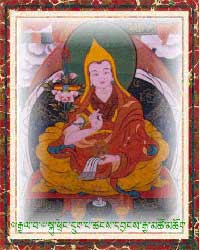Dalai Lama Tsangyang Gyatso
The Sixth Dalai Lama, Tsangyang Gyatso
The Sixth Dalai Lama, Tsangyang Gyatso, was born in 1682 in the region of Mon Tawang in present-day Arunachal Pradesh, India to Tashi Tenzin and Tsewang Lhamo.
In order to complete the Potala Palace, Desi Sangye Gyatso carried out the wishes of the Fifth Dalai Lama and kept his death a secret for fifteen years. People were told that the Great Fifth was continuing his long retreat. On important occasions the Dalai Lama's ceremonial gown was placed on the throne. However, when Mongol princes insisted on having an audience, an old monk called Depa Deyrab of Namgyal Monastery, who resembled the Dalai Lama, was hired to pose in his place. He wore a hat and eyeshadow to conceal the fact that he lacked the Dalai Lama's piercing eyes. The Desi managed to maintain this charade till he heard that a boy in Mon exhibited remarkable abilities. He sent his trusted attendants to the area and in 1688, the boy was brought to Nankartse, a place near Lhasa. There he was educated by teachers appointed by the Desi until 1697, when the Desi sent his trusted minister, Shabdrung Ngawang Shonu to the Manchu court to inform Emperor K'ang-si of the death of the Fifth and discovery of the Sixth Dalai Lama. He announced the fact to the people of Tibet, who greeted the news with gratitude and joy and thanked the Desi for saving them from lamenting the setting of the sun and, instead, making them rejoice in its rising.
The Desi invited the Fifth Pachen Lama, Lobsang Yeshi, to Nankartse, where Tibet[s second highest religious leader administered the vows of a novice monk to the youth and named him Tsangyang Gyatso. In 1697, the fourteen-year old was enthroned as the Sixth Dalai Lama in a ceremony attended by Tibetan government officials representing the three major monasteries -Sera, Gaden, and Drepung - Mongol princes, representatives of Emperor K'ang-si and the Lhasa populace.
In 1701 there was a conflict between the Desi and Lhasang Khan, the descendant of Gushir Khan, and the latter killed the Desi Sangya Gyatso, which disturbed the young Dalai Lama. He left his monastic study and chose the outdoor life, he had no plans to take the fully ordained vows. In fact, he visited the Panchen Lama in Shigatse and requested his forgiveness, and renounced even the vows of a novice monk. Though he continued to live in the Potala Palace, he roamed around Lhasa and other outlying villages, spending his days with his friends in the park behind the Potala Palace and nights in taverns in Lhasa and Shol (an area below the Potala) drinking chang and singing songs. He was known to be a great poet and writer and he wrote several poems. In 1706, he was invited to China and died on the way.
